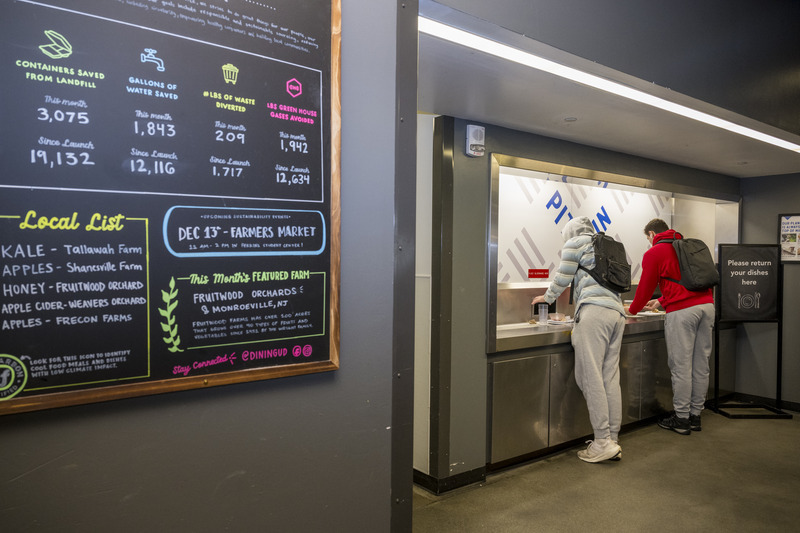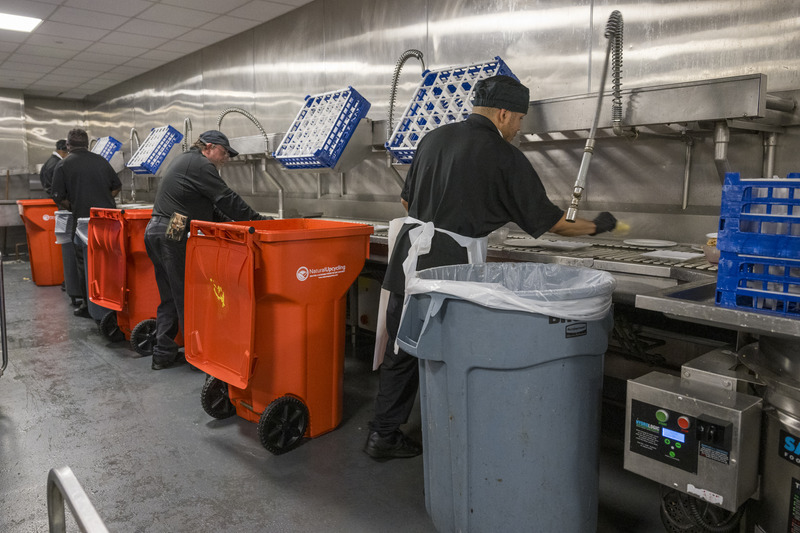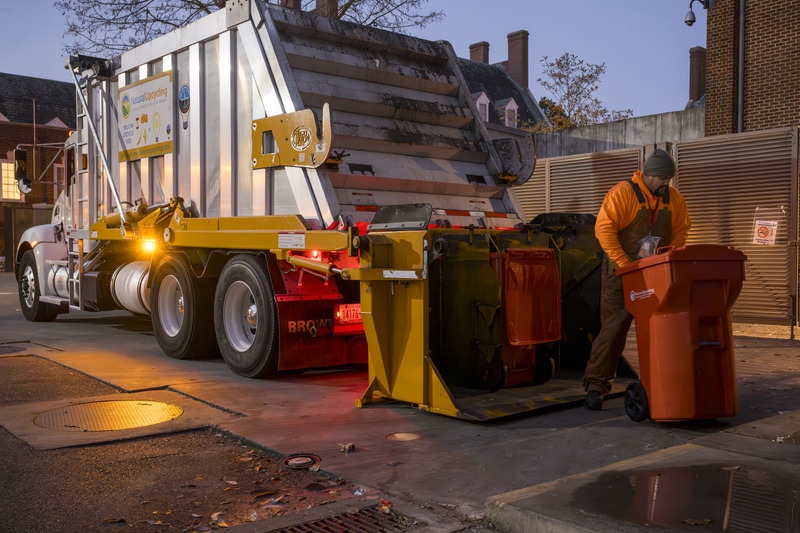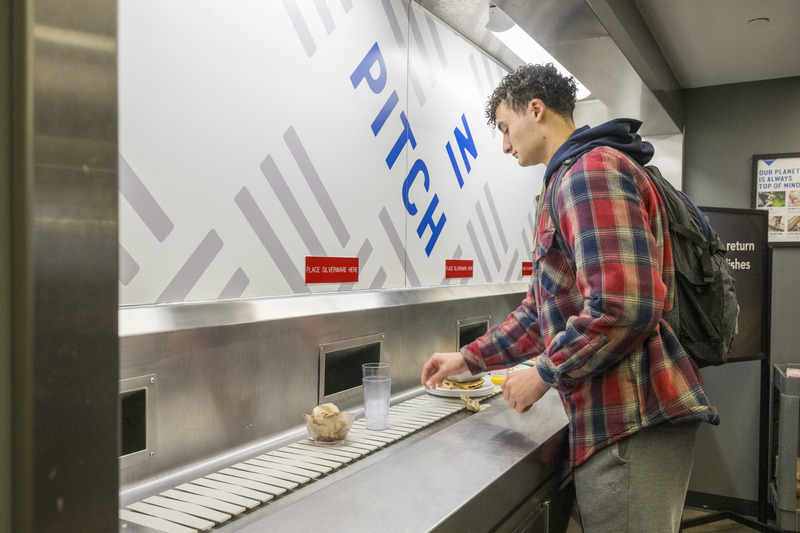

Race to zero waste: youtube.com/watch?v=S2bvCiL1_vY
Race to zero waste
Photos by Kathy F. Atkinson | Video by Samuel Kmiec and Jeffrey C. Chase April 22, 2024
UD reduces food waste by diverting as much as possible from landfills to composting sites
Imagine buying three gallons of milk at the store, driving home and pouring one of them down the sink. Or ordering three pizzas, then just dumping one of them into the garbage can.
That’s not just a bad idea. It’s what actually happens with food in the United States, according to the U.S. Environmental Protection Agency. More than a third of the food we produce is wasted, the EPA reported last year, whether it’s lost in processing, spoiled before it’s used or simply no longer wanted and tossed away.
Much of that discarded food winds up in landfills, where it rots to methane, one of the most potent greenhouse gasses.
Meanwhile, millions of Americans routinely wonder if they’ll have enough food for themselves and their households. The U.S. Department of Agriculture reported last year that more than 44 million Americans struggled with “food insecurity” — the inability to get enough food on a regular basis — in 2022.
Wasted food is a global concern for all of those reasons, and the University of Delaware is among many institutions working to address these problems.
UD has been part of the National Wildlife Federation’s Campus Race to Zero Waste competition, where scores of college campuses and several million students try to divert as much material away from landfills as possible. It is competing again this year, and a new pilot program that addresses food waste is part of that effort.

Part of the answer is to “rescue” food and reroute it to food banks and other non-profit agencies for distribution to those who need it. UD and its students and faculty have been part of such efforts in the past.
What to do with discarded food is a different challenge, and it is part of the University’s expanding effort to address sustainability from every possible angle.
UD’s Facilities, Real Estate and Auxiliary Services (FREAS) unit led the way on this front more than a decade ago, holding “zero waste” events that demonstrated how such things as compostable utensils and other recycling practices could keep a lot of waste out of landfills, said Mike Loftus, assistant director of Grounds Services for the University. Progress was made, but the coronavirus pandemic arrived, punching holes in many processes and plans.
Last year, when UD launched its Office of Sustainability, co-directors Jeffrey Summerhays, director of sustainable operations for FREAS, and Chris Williams, associate provost and professor of wildlife ecology, joined Loftus and Eric Bringman, resident district manager for Aramark at UD, in the effort.
And for the past six months, big silver trucks from Natural Upcycling have been stopping at five UD sites — dining halls and student centers — twice a week, collecting food waste from 64-gallon “toters.” The material is hauled to a nearby dairy farm in Pennsylvania or a larger facility in New Jersey, where it is processed for use as fertilizer and/or energy production.
These collections include waste from the “back of the house,” where food preparation is done, and from the “front of the house,” where students and other guests dine, Loftus said.
In October, the first month of the new pilot program, the trucks collected 17 tons — 34,000 pounds — of food waste, Loftus said.
“The biggest surprise for me is how much we’re collecting — the amount we don’t have to send to the landfill,” he said. “The amount of food waste that comes out was definitely a surprise.”

Many institutions throughout the Northeast have contracted with Natural Upcycling, which has a service area extending from New England to Washington D.C. Its annual collections — from restaurants, grocery stores, hospitals, schools, food manufacturers and distribution centers — exceed 100,000 tons of material. About 75% is recycled in anaerobic digesters, and the rest is composted.
The Office of Sustainability now is collecting benchmark data on food waste collection at UD. The true mark of success will be measured by how well UD cuts the amount of food waste produced, Summerhays said.
The Campus Race to Zero Waste competition makes a significant difference, NWF says. The 2023 competition included 3.4 million students and staff from 107 colleges and universities, kept more than 200 million single-use plastic containers out of landfills and prevented the release of the equivalent of 29,108 metric tons of carbon dioxide into the atmosphere. UD diverted 77 tons of materials from the landfill last year.
UD’s new ReusePass program — which provides incentives for students not to throw out food containers and beverage bottles — already has kept more than 27,000 single-use containers out of the landfill, Summerhays said, and the program has other benefits, too. More than 2,500 pounds of food waste was diverted and more than 17,000 pounds of carbon dioxide emissions were avoided, he said.
“The impact these colleges and universities have on reducing their waste footprint is tremendous and almost hard to comprehend,” said Kristy Jones, director of higher education programs at the National Wildlife Foundation.
Waste matters
It might seem natural for food to just be added to the garbage, as it has been for millennia. It will decompose soon enough, right? Many organic substances need a few months or years to decompose, but plastics — if not recycled or upcycled — will live somewhere on our planet for hundreds of years to come.
But food waste can cause significant environmental problems if it is not managed properly.
That’s why UD contracted with Natural Upcycling, which hauls the material to a nearby dairy farm or a larger processing plant in Trenton, New Jersey, where it is placed in an anaerobic digester, which Chris Williams describes as a big “organic crockpot.”
The bacterial communities in these no-oxygen tanks do the essential work, with microbes of many kinds chowing down on the tortilla chips, banana peels, pineapple cores, spinach and other morsels that arrive at their feeding machines.
By the time the microbes’ work is done, some of what remains can be used to fertilize fields and pasture lands that feed both crops and animals. The methane produced can be captured and redirected toward energy production, including electricity, biogas and heat.

Bringman considers this the easy part of dealing with food waste. You could call it low-hanging fruit.
The tough part is getting every diner to think harder about what they select for breakfast, lunch and dinner.
Bringman spends a good bit of time in the back of the house, watching trays return on conveyor belts to see what kind of food is coming back. He is often amazed by the quantity and quality of food that has been chosen by a diner but then left on the plate.
Getting diners to take only what they will eat, minimizing the food they discard, is Goal No. 1.
Resolve to use what you choose.
“If we can figure that out, the 34,000 pounds of food waste from October may drop to half that,” Bringman said. “And the next year, maybe it’s down to a third of its original volume.”
Bringman hopes this part of the challenge will be taken seriously by all diners.
“We’re doing something that’s making less of an environmental impact than before,” he said. “The next step is to reduce the waste, educating people on how to prevent the root cause of the waste. That’s our goal. The less they’re wasting, the less we’re buying and the less we’ll be paying to haul that waste away. That’s good for the environment and an economic advantage for UD.”
Loftus said he hopes to continue this project, but further evaluation is necessary. It costs more than he expected, he said, to ship these materials to an upcycling facility.
“I’m intending that we keep going,” he said. “We’re looking at the cost of it. But so far, the program seems to be going well.”
As diners make better choices, food waste will go down and the cost of upcycling that material will go down.
And tons of nutritious, delicious food will go where it’s supposed to go — into hungry bellies.

Contact Us
Have a UDaily story idea?
Contact us at ocm@udel.edu
Members of the press
Contact us at 302-831-NEWS or visit the Media Relations website

